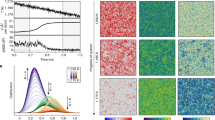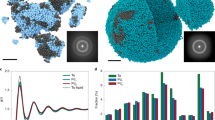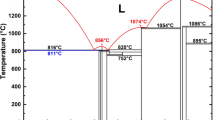Abstract
Amorphous and crystalline forms of silicon are well-known, tetrahedrally coordinated semiconductors. High-pressure studies have revealed extensive polymorphism among various metallic crystal structures containing atoms in six-, eight- and 12-fold coordination1,2. Melting silicon at ambient or high pressure results in a conducting liquid, in which the average coordination is greater than four (ref. 3). This liquid cannot normally be quenched to a glass, because of rapid crystallization to the diamond-structured semiconductor4. Solid amorphous silicon is obtained by synthesis routes such as chemical or physical vapour deposition that result in a tetrahedrally bonded semiconducting state. It has long been speculated that the amorphous solid and the liquid could represent two polymorphic forms of the amorphous state that are linked by density- or entropy-driven transformations5,6,7,8. Such polyamorphic transitions are recognized to occur among several different types of liquid and glassy systems9,10,11,12,13,14. Here we present experimental evidence for the occurrence of a density-driven polyamorphic transition between semiconducting and metallic forms of solid amorphous silicon. The experiments are combined with molecular dynamics simulations that map the behaviour of the amorphous solid on to that of the liquid state.
This is a preview of subscription content, access via your institution
Access options
Subscribe to this journal
Receive 12 print issues and online access
$259.00 per year
only $21.58 per issue
Buy this article
- Purchase on Springer Link
- Instant access to full article PDF
Prices may be subject to local taxes which are calculated during checkout




Similar content being viewed by others
References
Liu, L. -G. & Bassett, W. A. Elements, Oxides and Silicates: High Pressure Phases with Implications for the Earth’s Interior (Clarendon, Oxford, 1987).
Jakse, N. et al. Structural changes on supercooling liquid silicon. Appl. Phys. Lett. 83, 4734–4737 (2003).
Ansell, S. A., Krishnan, S., Felten, J. J. & Price, D. L. Structure of supercooled liquid silicon. J. Phys. Condens. Matter 10, L73–L78 (1998).
McMillan, P. F. Relaxing times for silicon. Nature Mater. 3, 755–756 (2004).
Aptekar, L. I. Phase transitions in noncrystalline germanium and silicon. Sov. Phys. Dokl. 24, 993–995 (1979).
Donovan, E. P., Spaepen, F., Turnbull, D., Poate, J. M. & Jacobson, D. D. Heat of crystallization and melting-point of amorphous-silicon. Appl. Phys. Lett. 42, 698–700 (1983).
Sastry, S. & Angell, C. A. Liquid-liquid phase transition in supercooled silicon. Nature Mater. 2, 739–743 (2003).
Deb, S. K., Wilding, M. C., Somayazulu, M. & McMillan, P. F. Pressure-induced amorphisation and an amorphous-amorphous transition in densified porous silicon. Nature 414, 528–530 (2001).
Ponyatovsky, E. G. & Barkalov, O. I. Pressure-induced amorphous phases. Mater. Sci. Rep. 8, 147–191 (1992).
Brazhkin, V. V., Popova, S. V. & Voloshin, R. N. High-pressure transformations in simple melts. High Pressure Res. 15, 267–305 (1997).
Poole, P. H., Grande, T., Angell, C. A. & McMillan, P. F. Polymorphic phase transitions in liquids and glasses. Science 275, 322–323 (1997).
Mishima, O. & Stanley, H. E. The relationship between liquid, supercooled and glassy water. Nature 396, 329–335 (1998).
Katayama, Y. et al. A first-order liquid-liquid phase transition in phosphorous. Nature 403, 170–173 (2000).
McMillan, P. F. Polyamorphic transformations in liquids and glasses. J. Mater. Chem. 14, 1506–1512 (2004).
McMillan, P. F. et al. Solid state synthesis of amorphous and nanocrystalline Si and Ge by a chemical metathesis route. J. Solid State Chem. 178, 937–949 (2005).
Brodsky, M. H. & Lurio, A. Infrared vibrational spectra of amorphous Si and Ge. Phys. Rev. B 9, 1646–1651 (1974).
Shuker, R. & Gammon, R. W. Raman scattering selection-rule breaking and the density of states in amorphous materials. Phys. Rev. Lett. 25, 222–225 (1970).
Gaál-Nagy, K. et al. Temperature and dynamical effects on the high-pressure cubic-diamond β -tin phase transition in Si and Ge. Phys. Status. Solidi b 211, 275–280 (1999).
Angell, C. A., Borick, S. A. & Grabow, M. Glass transitions and first-order liquid-metal-semiconductor transitions in 4-5-6 covalent systems. J. Non-Cryst. Solids 205–207, 463–471 (1999).
Shimomura, O. et al. Pressure-induced semiconductor-metal transitions in amorphous Si and Ge. Phil. Mag. 29, 547–558 (1974).
Imai, M., Mitamura, T., Yaoita, K. & Tsuji, K. Pressure-induced phase transition of crystalline and amorphous silicon and germanium at low temperatures. High Pressure Res. 15, 167–189 (1996).
Rapoport, E. Model for melting curve maxima at high pressure. J. Chem. Phys. 46, 2891–2894 (1967).
Wilson, M. & McMillan, P. F. Crystal-liquid phase relations in silicon at negative pressure. Phys. Rev. Lett. 90, 135703–135707 (2003).
Moynihan, C. T. & Angell, C. A. Bond-lattice or excitation model analysis of the configurational entropy of molecular liquids. J. Non-Cryst. Solids 274, 131–138 (2000).
Hedler, A., Klaumünzer, S. L. & Wesch, W. Amorphous silicon exhibits a glass transition. Nature Mater. 3, 804–809 (2004).
Stillinger, F. H. & Weber, T. Computer simulation of local order in condensed phases of silicon. Phys. Rev. B 31, 5262 (1985).
Duranduru, M. & Drabold, D. A. Ab initio simulation of first-order amorphous-to-amorphous phase transition of silicon. Phys. Rev. B 64, 014101 (2001).
Frenkel, D. & Smit, B. Understanding Molecular Simulation (Academic, New York, 1996).
Vink, R. L. C., Barkema, G. T. & van der Weg, W. F. Raman spectra and structure of amorphous Si. Phys. Rev. B 63, 115210 (2001).
Principi, E. et al. Polyamorphic transition of germanium under pressure. Phys. Rev. B 69, 201201(R) (2004).
Author information
Authors and Affiliations
Corresponding author
Ethics declarations
Competing interests
The authors declare no competing financial interests.
Rights and permissions
About this article
Cite this article
McMillan, P., Wilson, M., Daisenberger, D. et al. A density-driven phase transition between semiconducting and metallic polyamorphs of silicon. Nature Mater 4, 680–684 (2005). https://doi.org/10.1038/nmat1458
Received:
Accepted:
Published:
Issue Date:
DOI: https://doi.org/10.1038/nmat1458
This article is cited by
-
Microscopic mechanisms of pressure-induced amorphous-amorphous transitions and crystallisation in silicon
Nature Communications (2024)
-
Crystalline-amorphization-recrystallization structural transition and emergent superconductivity in van der Waals semiconductor SiP under compression
Science China Physics, Mechanics & Astronomy (2024)
-
Enhancement of short/medium-range order and thermal conductivity in ultrahard sp3 amorphous carbon by C70 precursor
Nature Communications (2023)
-
Percolation transitions in compressed SiO2 glasses
Nature (2021)
-
Relationship between diffraction peak, network topology, and amorphous-forming ability in silicon and silica
Scientific Reports (2021)



